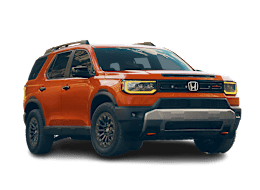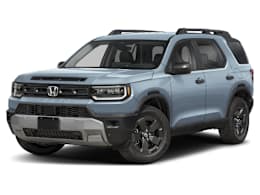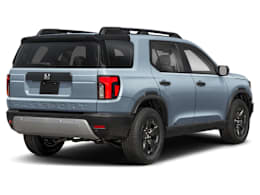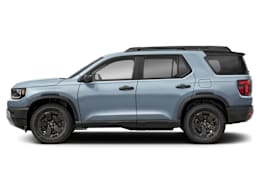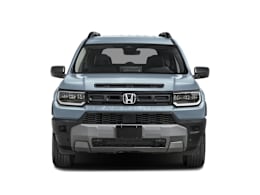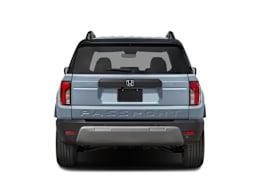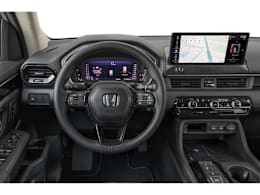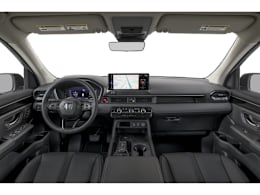The redesigned, fourth-generation Passport gives Honda an entry into the booming “off-road” marketing that’s being applied to car-based SUVs in every category. In the Passport’s case, it continues to use the basic structure and powertrain of Honda’s Pilot three-row midsized SUV. In fact, both SUVs share the same wheelbase (114 inches). However, the Passport is 8 inches shorter overall, has an extra inch of ground clearance, and features a much more burly, off-road look thanks to protective body cladding.
In reality, the Passport looks the off-road part more than it plays it, though that is unlikely to matter for most buyers. Think of it as a more civilized Toyota 4Runner. More importantly, the redesigned Passport is a better vehicle than before (shown by its higher road-test score), thanks in part to its smoother, more livable ride. It’s also one of the few remaining midsized SUVs with a naturally aspirated V6 engine, rather than a turbocharged four-cylinder.
During the months we spent testing the Passport, we found it to be an overwhelmingly positive experience, thanks to its good ride-to-handling mix, comfortable seats, roomy cabin, generous cargo room, and easy-to-use controls. Although we love the smooth and powerful V6, the transmission doesn’t perform as well, due to some low-speed hesitation and bumpy shifts.
It’s also a bit disappointing that Honda doesn’t yet have a hybrid powertrain for its midsized SUVs. Shoppers prioritizing fuel economy will need to look elsewhere within the Passport’s price range.
“Overall, I like the Passport, in particular its V6 engine,” said one of our testers. “That said, it’s splitting hairs a bit with the Pilot, and in some ways you're paying more for less, since it has similar dimensions but with a slightly smaller cargo area and no third row.”
Another tester said, “I found the Passport easy to live with. It has a fairly comfortable ride, decent steering feel, simple controls, great cargo and storage space, and a smooth V6. I think its rugged looks will prove to be popular. Unfortunately, the base audio system—like in most Hondas—is really lacking.”
We bought a 2026 Honda Passport RTL for $46,655—anonymously from an area dealer, as we do with every vehicle we test—for the purpose of this road test review. Our Passport was assembled in Lincoln, Alabama.
Driving experience
One of the Passports’ biggest strengths is its 285-hp, 3.5-liter V6 engine. It develops plenty of power without the need to rev it too high, which creates a quieter, less-stressful experience since the driver doesn’t need to mash the pedal often to accelerate. For example, there’s strong low-end power when pulling out of a side street.
Unfortunately, the 10-speed automatic transmission’s inconsistent operation keeps the driving experience from being completely drama-free. There’s a brief but noticeable hesitation when getting going, often followed by an abrupt power delivery, made worse during rolling stops, where it feels like the transmission is unsure of which gear to be in as the driver steps on the gas pedal. Upshifts can be rough, particularly in lower gears, and you feel the transmission downshifting when coming to a stop. On the bright side, the powertrain is more synchronized at higher speeds. We measured 21 mpg overall, which is the same as the previous generation and middle-of-the-road among two-row midsized SUVs.
The Passport is easy to drive during regular use, such as commuting or on road trips. The steering feels a bit light, but it turns into corners in a natural fashion while giving the driver at least some, though not a lot, of feedback. Amp up the pace on a twisty road, and body roll becomes noticeable, and it can feel slightly floaty at higher speeds when encountering undulations such as dips and rises. We found it more capable than engaging when pushed to its limits around our track, although the well-tuned electronic stability control (ESC) system kept the Passport in line. The suspension does a good job absorbing and smoothing out most road imperfections, though we noticed more side-to-side occupant jostling than in some other midsized SUVs.
Cabin comfort
The Passport’s interior is simple and clean, but it feels more “sturdy” than “flashy.” As such, it comes across as somewhat unremarkable, especially considering our RTL trim’s nearly $47,000 as-tested price. The cabin consists mostly of hard plastics, and the upper and lower front door pockets have very rough, visible lines from the mold used to cast them. Fortunately, the top of the dashboard is nicely padded, and the leather-wrapped steering wheel is pleasant to hold. Most of the controls and touch points feel respectably nice, particularly the chrome climate control knobs that click when engaging a setting.
There’s a wide range of seat and steering wheel adjustability, so most drivers should be able to find a comfortable position fairly easily. The cockpit is spacious, with generous headroom, and a wide, well-placed left footrest. We like that there’s a clear view of the gauges through the steering wheel. Taller drivers might find that their right knee rubs against the hard plastic center console.
The front seats are reasonably comfortable and supportive, though they don’t stand out in any way. Though the padding is on the firmer side, this lent itself to good long-haul comfort.
The rear seat is very roomy and provides ample headroom and knee room, along with decent underleg support. We were able to fit six large suitcases behind the Passport’s raised second-row seat, so there’s plenty of room to take a road trip with five people on board. After lowering the 60/40-split rear seat, we measured 47 cubic feet of maximum cargo room with our extendable pipe-box tool, which is a competitive figure among midsized SUVs.
Controls and usability
Most of the Passport’s controls consist of physical buttons and knobs that are logically located and within the driver’s easy reach. Honda uses well-labeled controls for the climate system, headlights, and windshield wipers, so the driver doesn’t have to divert their attention from the road when making adjustments for common tasks.
The infotainment system places icons for commonly used features in a static menu bar along the left side of the standard 12.3-inch touchscreen, making it easy to move among different functions. There are also dedicated physical buttons to return to the home screen or the previous menu, along with a small volume knob. Audio tuning, however, is done using the touchscreen, and only four audio presets are displayed at a time.
Honda’s push-button gear selector is flush-mounted on the center console. It requires some familiarity to use, and its setup means the driver will typically need to look down and over at the buttons rather than doing it by feel.
Active safety and driver assistance
All Passports come standard with automatic emergency braking with pedestrian detection, automatic emergency braking that operates at highway speeds, blind spot warning, rear cross traffic warning, reverse automatic emergency braking, lane centering assistance, lane departure warning, lane keeping assistance, adaptive cruise control, and automatic high beams.
We’re happy to see that the Passport comes standard with both a rear occupant alert system and a belt minder. The former is designed to remind the driver—based on rear-door logic—to check the rear seat at the end of a trip to help prevent children and pets from suffering heatstroke or hypothermia if unintentionally left behind in the vehicle. The rear belt minder alerts the driver if a rear passenger unbuckles their seat belt during the trip.



















